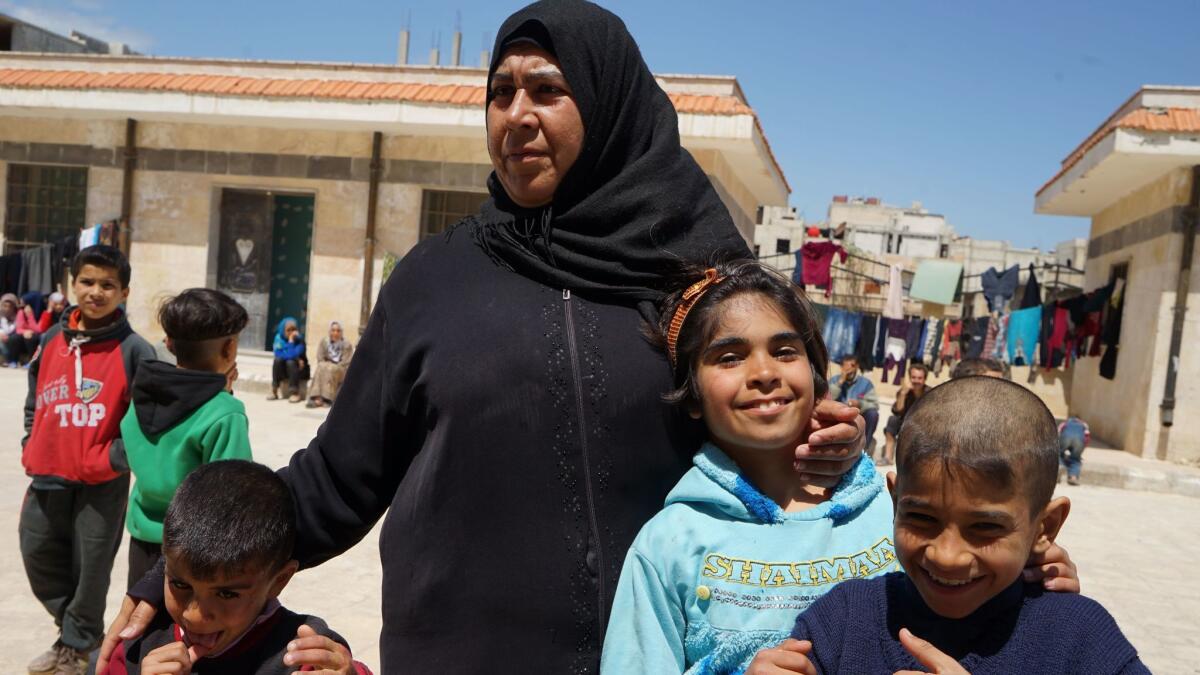She escaped Palmyra twice after Islamic State came to town. But her husband never made it out alive.

- Share via
Reporting from PALMYRA, SYRIA — Fariha Ziab’s family, like thousands of other residents in Palmyra, didn’t have time to get away when forces of Islamic State first stormed the town two years ago.
“They came for my husband at 4:45,” said Ziab, recalling the morning of May 21, 2015, when militants arrived at her home. “They took him and his cousin away.”
But Ziab and the children were spared, and eventually they were able to escape from Palmyra, the city adjacent to ancient ruins by the same name.
Ziab, 45, spoke recently from a school in the city of Homs, 90 miles to the west of Palmyra, where she and her five children reside in a former classroom divided with sheetrock walls to accommodate families.
Read more: Battered Syrian city offers a window into life under the thumb of Islamic State
Throughout Syria, schools have been turned into shelters to house some of the more than 6 million people internally displaced in the ruinous conflict pitting rebels against the government. An additional 5 million-plus Syrians have fled the country.
The former school where Ziab’s family is staying in the war-ravaged Bab Amr district — once a bastion of anti-government fighters — is home to 30 families, or about 170 people, all from Palmyra.
Islamic State’s destruction of the famed ruins has been widely documented — and condemned. Less known is the toll taken on Palmyra city. Called Tadmur in Arabic, the city was once home to 70,000 people. Now, it’s mostly deserted.
Some, like Ziab and her family, fled from the town twice — returning to Palmyra after Islamic State was initially ousted in March 2016, in what proved to be a fleeting reprieve. She and others took flight anew when the militants recaptured the city again last December.

The Syrian military, backed by Russian forces, finally drove the militants out of Palmyra in March, ending the group’s grip on what was once a vibrant provincial center that is now in ruins.
“My children were so terrified,” she recalled of her second escape from Palmyra in December, when she and her family walked for miles to escape the approaching militants. “The kids were saying, ‘They’ll catch us! We will be beheaded!’”
The second Islamic State takeover of Palmyra came at a moment when Syrian and allied Russian forces were focused on retaking the city of Aleppo, 130 miles to the north.
Islamic State’s second occupation was brief — the Syrians and Russians drove out the militants in March — but in those four months the jihadists once again imposed their strict form of Sunni Islam and carried out executions indiscriminately. They had done as much during their first occupation of Palmyra — when they came for Ziab’s husband.
Her husband, Khaled Mohammed Hamood, 46, was a farmer and a member of a pro-government militia, she said. The latter affiliation sealed his fate.
Four days after her husband was detained, Ziab said, she went to an Islamic State post in town to inquire about his whereabouts and that of his female cousin, Rasha Fahed, 27, who was seized from the family house the same morning.
“They were both slaughtered,” an Islamic State functionary informed her, Ziab said.
No other explanation was proffered. The grieving widow was not told of her husband’s burial place. She and her family managed to leave Palmyra a few weeks later, fleeing south toward the Jordanian border.
Ziab says she hopes to go back someday to Palmyra, which she recalls mostly as a peaceful town, a good place for a family — until Islamic State.
twitter: @mcdneville
More to Read
Sign up for Essential California
The most important California stories and recommendations in your inbox every morning.
You may occasionally receive promotional content from the Los Angeles Times.










